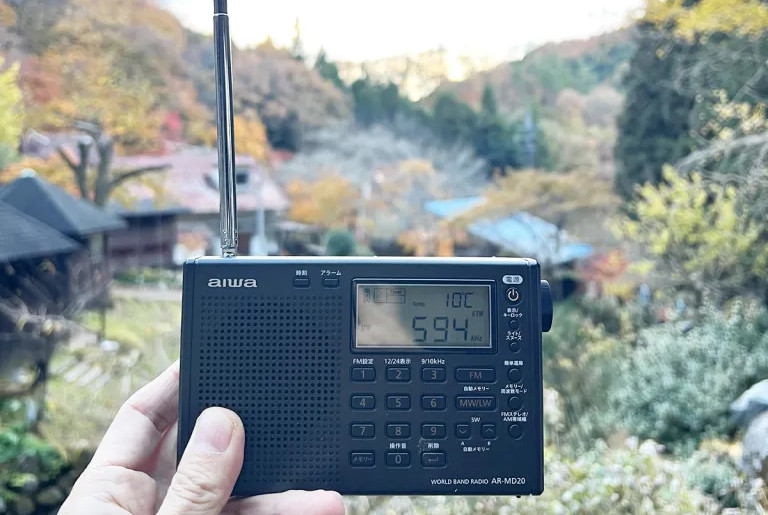
It was kind of scary, kind of cool, and definitely eye opening.
Our Japanese-language reporter Go Hatori has been hard at work helping the team spruce up the SoraHouse, our middle-of-nowhere, up-in-the-mountains house in Saitama Prefeture, by giving it zero-cost electricity and de-roachifying it. All that work and no play makes our reporters dull, of course, so Go brought up a shortwave radio to experiment with and see what kind of interesting international channels he could find. As he shuffled through the available frequencies, he heard some very surprising statements in Japanese:
“The secretary of our beloved and respected leader Kim Jong Un…”
“Our indomitable faith in and conviction for revolution…”
“Comrades of our beloved and respected Kim Jong Un…”
“On November 23, the launch of our first spy satellite…”
Yes…Go’s radio was picking up propaganda from North Korea–broadcast in Japanese! Go had known that North Korea broadcast its propaganda, but not that they did it in Japanese. This opened him up to a whole new set of realizations.
Let’s go back a bit. Recently, Go randomly became curious about radio waves and started looking into the subject. As most people already know, there are two main types of broadcasting: AM and FM. AM is received via medium-frequency radio waves, which have a frequency of 526.5 to 1606.6 kilohertz. They can reach a wide area. FM radio, on the other hand, is broadcasted with ultra-short waves which have a low frequency of 76.1 to 94.9 megahertz, allowing them to reach a medium-sized area (between 10 to 100 kilometers [6.2 to 62 miles]).
However, there is one other category called short-wave broadcasting, whose waves are only 3 to 30 megahertz of frequency but can actually reach extremely far, even overseas. According to what Go read on the website of the Japanese Ministry of Internal Affairs and Communications, these waves reverberate off the surface of the earth, so they can actually be transmitted to the other side of the planet.
If you have a radio that can read these short waves, you can listen to these broadcasts. This piqued Go’s interest, so some time ago he bought a cheap shortwave radio for 1,479 yen (US$10) and took it back up with him into the mountains of Saitama to see what kind of waves it would pick up from the SoraHouse. There he was able to listen to broadcasts in Mandarin, Cantonese, Russian, and Korean (from South Korea).
That only served to deepen Go’s interest, so he decided to do some research. He purchased a book called The Radio Wave Bible 2023, which taught him that there are so many different kinds of radios that he’d never heard about. Among them, listed in the book as “having no perceivable flaws” was one radio that came highly recommended: the World Band Radio Aiwa AR-MD20, which Go recently upgraded to by purchasing one on Amazon for about 10,000 yen.
The main appeal of this second radio is that unlike Go’s cheap starter shortwave radio, it has easy tuning. Instead of requiring you to very carefully and slowly turn a dial to find a channel, you can instead found receivable stations through the push of a single button. Equipped with this new equipment, on his next trip to the SoraHouse Go tried out his AR-MD20.
He first tried FM radio, which picked up all of the Tokyo stations, plus three more, including one from Aichi, one from Osaka, and even one from China. He had even more success with AM radio, which got a whopping 24 channels, not only from Tokyo but all over northeastern Japan, even from as far as the northern island of Hokkaido, as well as a couple from South Korea.
But the real improvement was in the shortwave broadcasting, which picked up an impressive 28 separate channels. There were, of course, Japanese channels, but Go heard languages from around the world, including Chinese, Korean (from South Korea), English, Russian, and other languages he didn’t recognize.
▼ You can watch Go scrolling through the different shortwave stations below.
Among those was a Japanese-language channel that was broadcasting strange things at a frequency of 7,580 kilohertz. As Go leaned in to listen more closely he heard:
“The secretary of our beloved and respected leader Kim Jong Un announces that we have achieved a groundbreaking advancement in our republic’s defensive capabilities with the launch of our spy satellite. We have determined that the scientists and engineers of the National Aerospace Technology Office, which have splendidly and accurately accomplished the determination of the party, have been even more inspired to develop our aerospace reconnaissance abilities according to the party’s current directive goals and prospects and have vigorously been striving to make progress. In celebration, a photo was taken to commemorate the event.”
▼ A video recording of Go as he found the broadcast
That was definitely from North Korea! And they were talking about the satellite they’d launched using ballistic missile technology that had passed over Japanese airspace recently, which Go had heard about on the news. He had a vague memory of hearing about North Korea using short-waves to transmit codes and other broadcasts, but he would never have expected them to use them to broadcast in Japanese.
Go later looked into it and learned that what he heard is a program known as “Voice of Korea”, which is transmitted directly from Pyongyang. Hearing it broadcast on the radio, and knowing that such a satellite had flown over Japanese airspace made for a rather shocking experience for Go. With such a broadcast–and such a satellite–flying over the sea and being received in the remote mountains of Saitama, it really made him realize that the whole world is connected by the great blue, cloudy expanse of the sky.
Images © SoraNews24
● Want to hear about SoraNews24’s latest articles as soon as they’re published? Follow us on Facebook and Twitter!
[ Read in Japanese ]

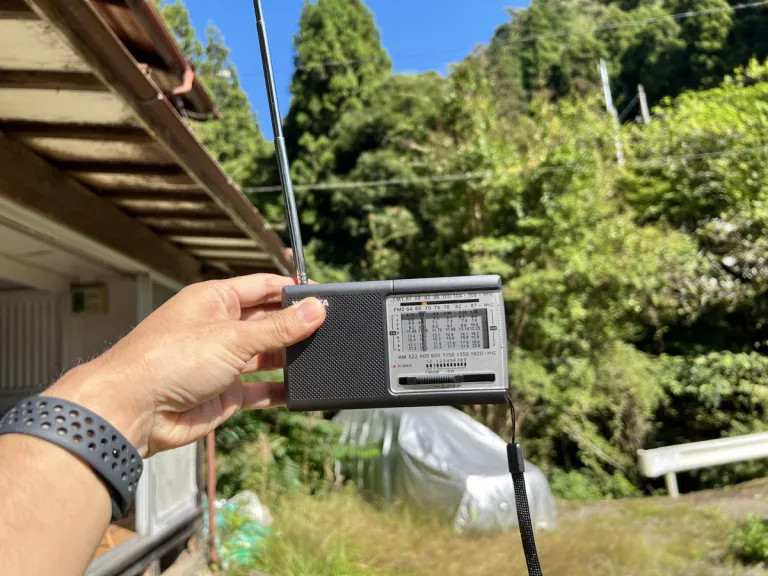
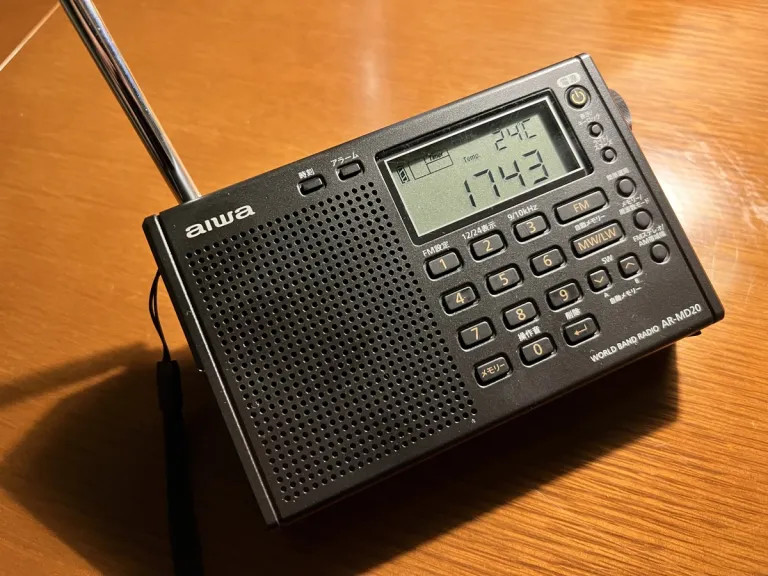
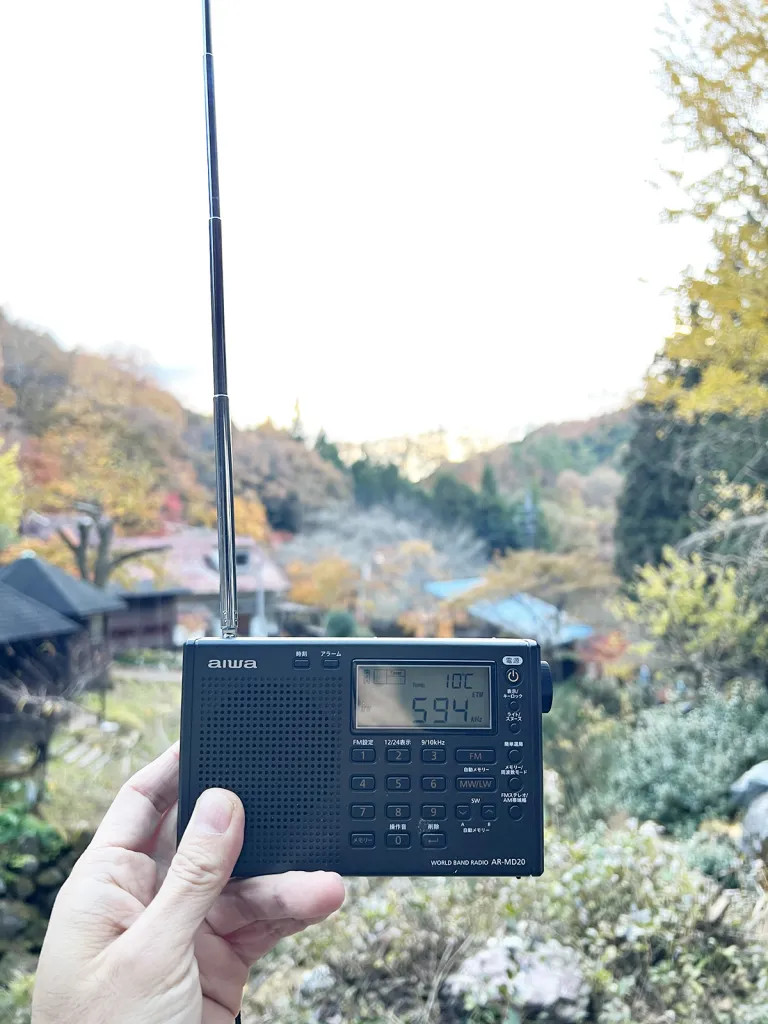
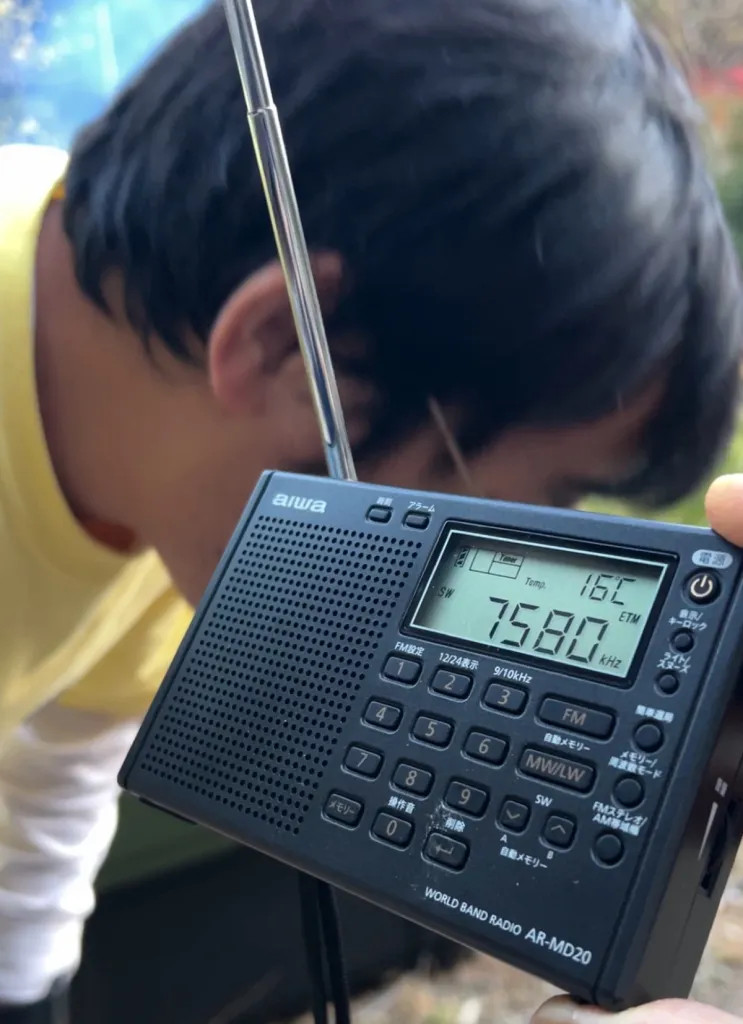
 8 ways Kim Jong-Un has blindsided the US
8 ways Kim Jong-Un has blindsided the US COVID-19 turnabout—pandemic in Japan unexpectedly revives, instead of exterminates, a dying art
COVID-19 turnabout—pandemic in Japan unexpectedly revives, instead of exterminates, a dying art Sazae Radio: Now you can hear a lot more than just the ocean in a seashell!
Sazae Radio: Now you can hear a lot more than just the ocean in a seashell! Is North Korea really forcing its young men to get Kim Jong-un’s haircut? Probably not…
Is North Korea really forcing its young men to get Kim Jong-un’s haircut? Probably not… America admits it has no idea what Kim Jong-un is doing
America admits it has no idea what Kim Jong-un is doing How to order snacks on a Shinkansen bullet train in Japan
How to order snacks on a Shinkansen bullet train in Japan Burger King Japan suddenly adds Dr. Pepper and Dr. Pepper floats to its menu nationwide
Burger King Japan suddenly adds Dr. Pepper and Dr. Pepper floats to its menu nationwide New Nintendo Lego kit is a beautiful piece of moving pixel art of Mario and Yoshi【Photos】
New Nintendo Lego kit is a beautiful piece of moving pixel art of Mario and Yoshi【Photos】 Hello, cosmetics! Clinique teams up with Hello Kitty this summer for first-time collaboration
Hello, cosmetics! Clinique teams up with Hello Kitty this summer for first-time collaboration Demon Slayer: Kimetsu no Yaiba gets new roller coaster attractions and food at Universal Studios Japan
Demon Slayer: Kimetsu no Yaiba gets new roller coaster attractions and food at Universal Studios Japan 11 different ways to say “father” in Japanese
11 different ways to say “father” in Japanese Kyoto tea merchant’s matcha parfait ice cream bars: The desserts we’ve been waiting 187 years for
Kyoto tea merchant’s matcha parfait ice cream bars: The desserts we’ve been waiting 187 years for East meets West in the Pacific-centered version of the world map
East meets West in the Pacific-centered version of the world map What do you eat when you catch a cold? We asked 11 of our Japanese reporters
What do you eat when you catch a cold? We asked 11 of our Japanese reporters Shinjuku izakaya’s all-you-can-eat-and-drink plan is one of Tokyo’s best secret cheap eats
Shinjuku izakaya’s all-you-can-eat-and-drink plan is one of Tokyo’s best secret cheap eats Nintendo history you can feel – Super NES, N64, and GameCube controllers become capsule toys
Nintendo history you can feel – Super NES, N64, and GameCube controllers become capsule toys “The most Delicious Cup Noodle in history” – Japan’s French Cup Noodle wins our heart【Taste test】
“The most Delicious Cup Noodle in history” – Japan’s French Cup Noodle wins our heart【Taste test】 Starbucks releases a cute Frappuccino and Unicorn Cake…but not in Japan
Starbucks releases a cute Frappuccino and Unicorn Cake…but not in Japan Kyoto Tower mascot termination reveals dark side behind cute Japanese characters
Kyoto Tower mascot termination reveals dark side behind cute Japanese characters McDonald’s Japan’s Soft Twist Tower: A phantom ice cream only sold at select branches
McDonald’s Japan’s Soft Twist Tower: A phantom ice cream only sold at select branches Yabai Ramen: What makes this Japanese ramen so dangerous?
Yabai Ramen: What makes this Japanese ramen so dangerous? Finally! Nintendo Japan expands Switch 8-bit controller sales to everybody, Online member or not
Finally! Nintendo Japan expands Switch 8-bit controller sales to everybody, Online member or not Japanese government wants to build luxury resorts in all national parks for foreign tourists
Japanese government wants to build luxury resorts in all national parks for foreign tourists To combat declining birth rate, Japan to begin offering “Breeding Visas” to foreigners
To combat declining birth rate, Japan to begin offering “Breeding Visas” to foreigners 10 things you should buy at 7-Eleven in Japan
10 things you should buy at 7-Eleven in Japan Studio Ghibli releases anime heroine cosplay dresses that are super comfy to wear
Studio Ghibli releases anime heroine cosplay dresses that are super comfy to wear Woman charged for driving suitcase without a license in Osaka
Woman charged for driving suitcase without a license in Osaka Studio Ghibli unveils My Neighbour Totoro miniature house model
Studio Ghibli unveils My Neighbour Totoro miniature house model Kyoto experiencing problems with foreign tourists not paying for bus fares, but not on purpose
Kyoto experiencing problems with foreign tourists not paying for bus fares, but not on purpose Fighting mild hunger with a Japanese soda that turns into jelly in the stomach【Taste test】
Fighting mild hunger with a Japanese soda that turns into jelly in the stomach【Taste test】 Studio Ghibli’s Howl’s Moving Castle tapestry unveiled in Japan for first time
Studio Ghibli’s Howl’s Moving Castle tapestry unveiled in Japan for first time McDonald’s new Happy Meals offer up cute and practical Sanrio lifestyle goods
McDonald’s new Happy Meals offer up cute and practical Sanrio lifestyle goods Sales of Japan’s most convenient train ticket/shopping payment cards suspended indefinitely
Sales of Japan’s most convenient train ticket/shopping payment cards suspended indefinitely Sold-out Studio Ghibli desktop humidifiers are back so Totoro can help you through the dry season
Sold-out Studio Ghibli desktop humidifiers are back so Totoro can help you through the dry season Japanese government to make first change to romanization spelling rules since the 1950s
Japanese government to make first change to romanization spelling rules since the 1950s Foreigner’s request for help in Tokyo makes us sad for the state of society
Foreigner’s request for help in Tokyo makes us sad for the state of society Ghibli founders Toshio Suzuki and Hayao Miyazaki contribute to Japanese whisky Totoro label design
Ghibli founders Toshio Suzuki and Hayao Miyazaki contribute to Japanese whisky Totoro label design Doraemon found buried at sea as scene from 1993 anime becomes real life【Photos】
Doraemon found buried at sea as scene from 1993 anime becomes real life【Photos】 Tokyo’s most famous Starbucks is closed
Tokyo’s most famous Starbucks is closed Princesses, fruits, and blacksmiths: Study reveals the 30 most unusual family names in Japan
Princesses, fruits, and blacksmiths: Study reveals the 30 most unusual family names in Japan North Korean official put to death after twisting song lyrics during karaoke session
North Korean official put to death after twisting song lyrics during karaoke session The dirty reason China can’t always tell North Korea what to do
The dirty reason China can’t always tell North Korea what to do Digimon staff give skating champion Yuzuru Hanyu a present he would not likely soon forget
Digimon staff give skating champion Yuzuru Hanyu a present he would not likely soon forget North Korean defector describes her crazy escape and adjustment to modern life
North Korean defector describes her crazy escape and adjustment to modern life Japanese radio host arrested after beating female co-host with microphone during live broadcast
Japanese radio host arrested after beating female co-host with microphone during live broadcast North Korea calls US the ‘World’s Worst Human Rights Abuser’
North Korea calls US the ‘World’s Worst Human Rights Abuser’ Pen-Pineapple-Apple-Pen singer accidentally gives epic stink eye to rival Japanese musician
Pen-Pineapple-Apple-Pen singer accidentally gives epic stink eye to rival Japanese musician The power of fast food: Supreme Leader Kim Jong-un wants McDonald’s to invest in North Korea
The power of fast food: Supreme Leader Kim Jong-un wants McDonald’s to invest in North Korea Japanese chef shows off amazing cooking skills with high-flying omelettes 【Video】
Japanese chef shows off amazing cooking skills with high-flying omelettes 【Video】 North Korea-U.S. tensions spark interest in Japanese government’s J-Alert warning system
North Korea-U.S. tensions spark interest in Japanese government’s J-Alert warning system Inside the luxury Chinese hotel where North Korea keeps its army of hackers
Inside the luxury Chinese hotel where North Korea keeps its army of hackers Kim Jong-un’s face on one-piece romper suit available online, because that’s the world we live in
Kim Jong-un’s face on one-piece romper suit available online, because that’s the world we live in Ultra-cute moe pilgrims embark on Shikoku’s 88-temple journey in new TV show
Ultra-cute moe pilgrims embark on Shikoku’s 88-temple journey in new TV show Baffling building in Japan looks like a graphics glitch in real life
Baffling building in Japan looks like a graphics glitch in real life Rare photos from inside North Korea’s mysterious buildings
Rare photos from inside North Korea’s mysterious buildings Saitama senior arrested after calling telecom provider 24,000 times to complain
Saitama senior arrested after calling telecom provider 24,000 times to complain
Leave a Reply